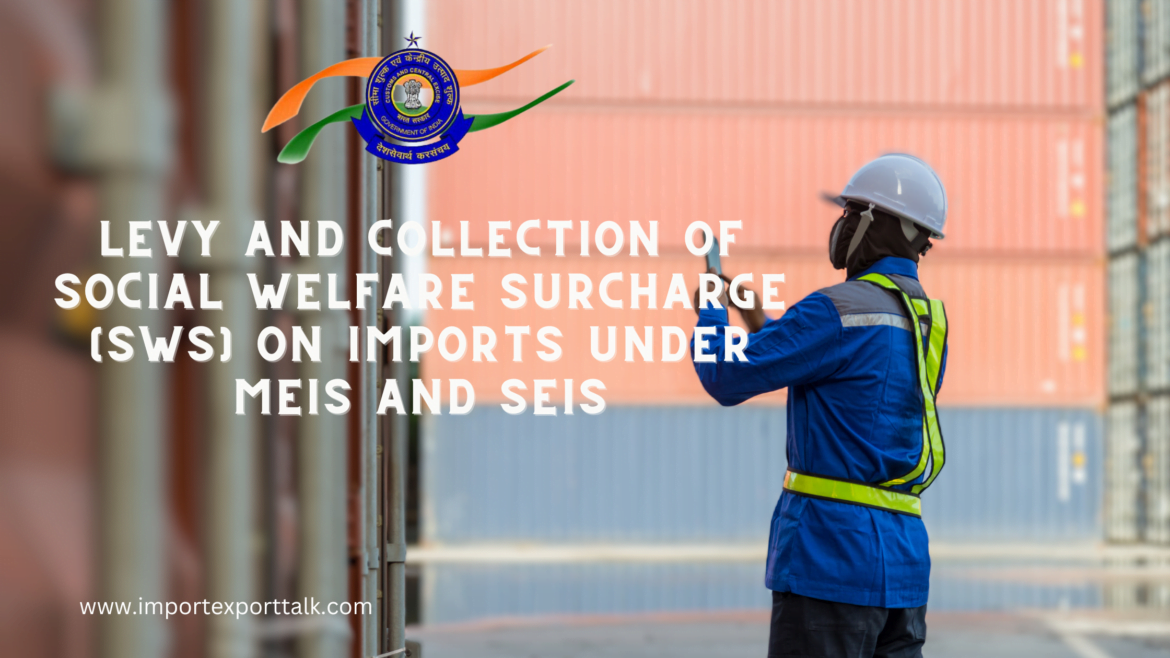Table of Contents
India’s international trade policy has been instrumental in promoting exports and boosting economic growth. One such initiative is the Merchandise Exports from India Scheme (MEIS) and the Service Exports from India Scheme (SEIS), which aim to incentivize exports of goods and services. However, the government introduced the Social Welfare Surcharge (SWS) on certain imports under the MEIS and SEIS schemes.
The MEIS and SEIS are export incentive schemes implemented by the Directorate General of Foreign Trade (DGFT). The MEIS focuses on merchandise exports and provides duty credit scrips to exporters based on their export turnover. These scrips can be used to pay customs duties or can be traded to other exporters.
On the other hand, the SEIS focuses on services exports and provides exporters with duty credit scrips based on their net foreign exchange earnings. The scrips can be utilized for payment of various duties, taxes, and fees.
Both schemes aim to promote exports, enhance export competitiveness, and boost foreign exchange earnings. They provide significant benefits to exporters, encouraging them to explore new markets and diversify their product or service offerings.
In the Union Budget of 2018-19, the Indian government introduced the Social Welfare Surcharge (SWS) as a measure to contribute to social welfare initiatives. The SWS is applicable to certain imports under the MEIS and SEIS schemes. It is levied at a specific rate, calculated as a percentage of the total customs duty payable on imported goods.
The primary objective behind the imposition of SWS is to generate additional revenue for financing various social welfare programs and projects in the country. The revenue generated from SWS is allocated towards initiatives such as education, healthcare, infrastructure development, and poverty alleviation.
Circular on the Levy and Collection of SWS :
The Central Board of Indirect Taxes and Customs (CBIC) issued a circular to provide clarity on the levy and collection of SWS on imports under MEIS and SEIS. The circular outlines the following key points:
- Scope of SWS: The circular specifies the categories of imported goods that are subject to the levy of SWS. The surcharge is imposed on specific items to ensure that it does not impact essential commodities and sectors crucial for economic growth.
- Rate of SWS: The circular outlines the applicable rate of SWS on different categories of imported goods. The rate may vary based on the nature of the goods and the intended social welfare initiatives.
- Calculation and Payment: The circular provides guidance on the calculation of SWS and the manner of its payment. Importers are required to calculate the surcharge based on the customs duty payable on the imported goods and remit it along with other duties and taxes.
- Utilization of SWS Revenue: The circular emphasizes the utilization of the revenue generated from SWS towards designated social welfare programs and initiatives. The funds collected are directed towards projects aimed at uplifting marginalized communities, supporting healthcare facilities, improving educational infrastructure, and promoting sustainable development.
- Compliance and Reporting: The circular stresses the importance of compliance with the provisions of SWS and requires importers to maintain proper records and documentation related to the payment of the surcharge.
Implications on Trade and Social Welfare Initiatives :
- Revenue Generation: The levy of SWS has resulted in the generation of additional revenue for the government. This revenue is directed towards funding essential social welfare initiatives, contributing to the overall development of the nation.
- Balancing Exports and Imports: The imposition of SWS on select imports helps in balancing the incentives provided to exporters under the MEIS and SEIS schemes. It ensures that the benefits provided for exports are partially offset by the surcharge on certain imports, promoting a level playing field for domestic industries.
- Funding Social Welfare Programs: The SWS has played a vital role in supporting social welfare programs in the country. By channeling funds towards education, healthcare, and infrastructure development, the government aims to improve the quality of life and create opportunities for marginalized sections of society.
- Incentivizing Domestic Production: The SWS on imports can incentivize domestic production and manufacturing, as it discourages excessive reliance on imports for certain goods. This can boost the domestic manufacturing sector and enhance India’s self-reliance in critical areas.
- Compliance and Administration: The successful implementation of SWS relies on efficient compliance and administration. Customs authorities must ensure proper collection, remittance, and utilization of SWS revenue while importers must adhere to the guidelines laid out in the circular.
Levy and Collection of SWS on Imports under MEIS and SEIS Circular-No-02-2020_Customs
The circular on the levy and collection of Social Welfare Surcharge (SWS) on imports under MEIS and SEIS reflects the government’s commitment to fostering a balanced approach towards promoting exports and contributing to social welfare initiatives. The SWS serves as a means to generate additional revenue for essential social welfare programs, while the MEIS and SEIS schemes incentivize exports, boost foreign exchange earnings, and enhance the competitiveness of Indian exporters. A well-executed implementation of the SWS will play a crucial role in uplifting marginalized communities, supporting infrastructure development, and creating a sustainable and inclusive growth path for India. Importers, exporters, and other stakeholders must ensure compliance with the provisions of SWS, contributing collectively towards the nation’s growth and development agenda.
The Shipping Bills for Export
Trade Settlement in Indian Rupees (INR)


1 comment
[…] Circular on Levy and Collection of SWS on Imports under MEIS and SEIS […]